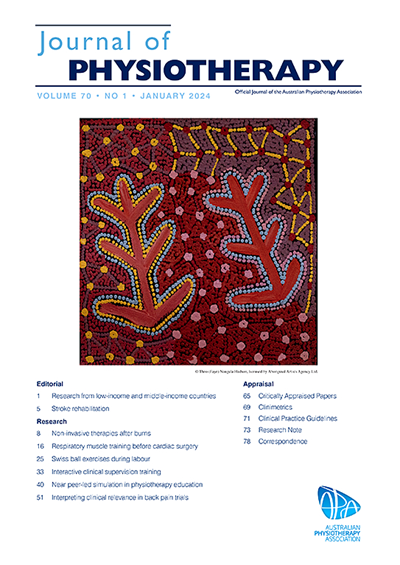竞技性艺术体操运动员在常规训练中进行盆底肌肉训练并不能减少尿失禁:一项集群随机试验。
IF 9.7
1区 医学
Q1 ORTHOPEDICS
引用次数: 0
摘要
问题包括盆底肌肉训练(PFMT)在内的扩展热身计划与通常的热身计划相比,对韵律操运动员尿失禁(UI)的困扰和患病率有何影响?骨盆底肌肉训练的自我感觉效果如何,包括其随着时间推移的进展情况(通过总体变化评分进行评估)?分组随机对照试验,采用隐蔽分配和意向治疗分析法:体操运动员年龄必须≥ 12 岁,每周接受艺术体操训练≥ 3 天。23个艺术体操俱乐部被随机分为实验组(12个俱乐部,119名体操运动员)或对照组(11个俱乐部,86名体操运动员):干预措施:实验组在 8 个月的每次训练前进行一组 8 至 12 次接近最大限度的骨盆底肌肉收缩以及膝盖、腰部和臀部/腹股沟运动,作为热身运动。对照组照常进行韵律体操训练,不做盆底肌收缩训练或额外的下背部和下肢运动:主要结果为尿失禁困扰(0 至 21 分)和尿失禁患病率,均通过尿失禁国际咨询问卷-尿失禁简表(ICIQ-UI-SF)进行测量。次要结果指标是自我感觉效果及其随时间推移的进展情况,采用总体变化评分法(-5 至 5)进行评估:结果:两组在 ICIQ-UI-SF 总分(即 UI 困扰)上的差异明显可以忽略不计(MD -0.48,95% CI -1.27 至 0.31)。实验组的 UI 患病率从 46% 降至 41%,而对照组则从 32% 升至 34%;尽管如此,8 个月时的风险差异仍可忽略不计(RD 0.07),置信区间主要为可忽略不计的影响(95% CI -0.08 至 0.21)。实验组参与者对其总体变化的平均评价为 2.1(标准差 1.7):结论:在韵律操训练课前进行为期八个月的热身,其中包括一组 8 至 12 次接近最大限度的 PFM 收缩,并不会减少尿失禁的困扰。结论:在韵律操训练前进行为期八个月的热身运动,包括一组 8 至 12 次接近最大限度的 PFM 收缩,并不能减少尿频困扰,对尿失禁发生率的影响也可能微乎其微,尽管实验组参与者认为干预措施带来了益处:注册:ClinicalTrials.gov NCT05506579。本文章由计算机程序翻译,如有差异,请以英文原文为准。
Pelvic floor muscle training by competitive rhythmic gymnasts at regular training sessions did not reduce urinary incontinence: a cluster-randomised trial
Question
What is the effect of an expanded warm-up program including pelvic floor muscle training (PFMT) compared with usual warm-up on bother and prevalence of urinary incontinence (UI) among rhythmic gymnasts? What is the self-perceived effect of PFMT, including its progression over time, assessed via the global rating of change?
Design
A cluster-randomised controlled trial with concealed allocation and intention-to-treat analysis.
Participants
Gymnasts had to be ≥ 12 years of age and training in rhythmic gymnastics ≥ 3 days/week. Twenty-three rhythmic gymnastics clubs were randomised to an experimental group (12 clubs, 119 gymnasts) or a control group (11 clubs, 86 gymnasts).
Intervention
The experimental group performed one set of 8 to 12 near-maximum pelvic floor muscle contractions and exercises for the knees, lower back and hip/groin as warm-up before each training session for 8 months. The control group continued rhythmic gymnastics training as usual without PFMT or additional lower back and lower limb exercises.
Outcome measures
Primary outcomes were bother from UI (score 0 to 21) and prevalence of UI, each measured by the International Consultation on Incontinence Questionnaire - Urinary Incontinence Short Form (ICIQ-UI-SF). The secondary outcome measure was the self-perceived effect and its progress over time, assessed using the global rating of change (–5 to 5).
Results
The difference between the groups in the ICIQ-UI-SF total score (ie, UI bother) was clearly negligible (MD –0.48, 95% CI –1.27 to 0.31). The prevalence of UI reduced from 46 to 41% in the experimental group and increased from 32 to 34% in the control group; despite this, the risk difference at 8 months was negligible (RD 0.07) and the confidence interval spanned mainly negligible effects (95% CI –0.08 to 0.21). Experimental group participants rated their global change at a mean of 2.1 (SD 1.7).
Conclusion
Eight months of warm-up before rhythmic gymnastics training sessions that included one set of 8 to 12 near-maximum PFM contractions did not reduce UI bother. The effect on UI prevalence was also likely to be negligible, despite experimental group participants perceiving benefit from the intervention.
Registration
ClinicalTrials.gov NCT05506579
求助全文
通过发布文献求助,成功后即可免费获取论文全文。
去求助
来源期刊

Journal of Physiotherapy
ORTHOPEDICS-REHABILITATION
CiteScore
11.40
自引率
7.40%
发文量
69
审稿时长
72 days
期刊介绍:
The Journal of Physiotherapy is the official journal of the Australian Physiotherapy Association. It aims to publish high-quality research with a significant impact on global physiotherapy practice. The journal's vision is to lead the field in supporting clinicians to access, understand, and implement research evidence that will enhance person-centred care. In January 2008, the Journal of Physiotherapy became the first physiotherapy journal to adhere to the ICMJE requirement of registering randomized trials with a recognized Trial Registry. The journal prioritizes systematic reviews, clinical trials, economic analyses, experimental studies, qualitative studies, epidemiological studies, and observational studies. In January 2014, it also became the first core physiotherapy/physical therapy journal to provide free access to editorials and peer-reviewed original research. The Australian Physiotherapy Association extended their support for excellence in physiotherapy practice by sponsoring open access publication of all Journal of Physiotherapy content in 2016. As a result, all past, present, and future journal articles are freely accessible, and there are no author fees for publication.
 求助内容:
求助内容: 应助结果提醒方式:
应助结果提醒方式:


